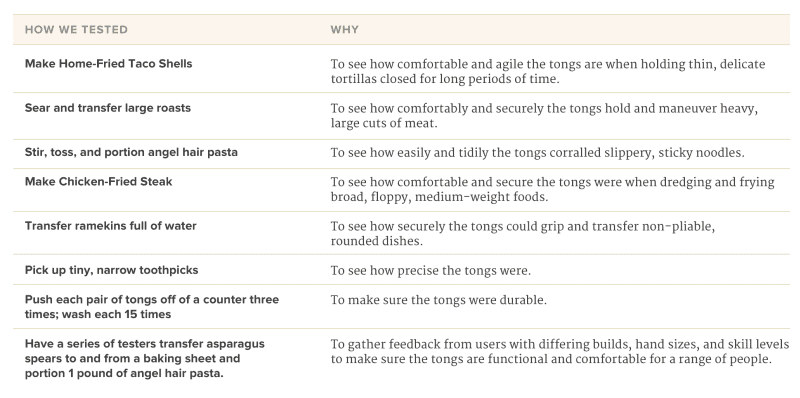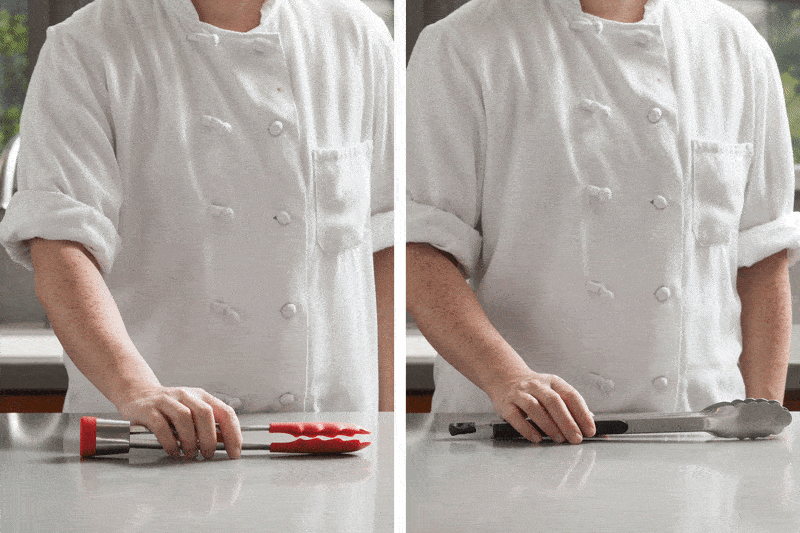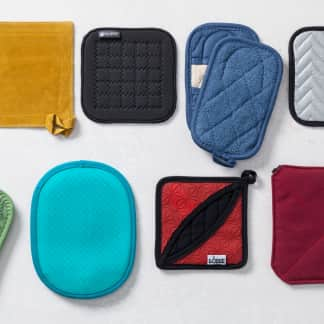Tongs look simple: two arms connected by a hinge. Pinch ’em together, pick something up. But this kitchen utensil is surprisingly complex.
When we previously tested tongs, the OXO Good Grips 12-Inch Tongs were our favorite; they gripped foods well and were comfortable to hold. But with new models on the market, we decided to retest. We included tongs that were 10 to 12 inches long and had a variety of pincer designs, from scalloped to straight-edged.

Tongs have many uses, so we tested them in a variety of ways, including handling and frying delicate tortillas to make taco shells, rotating and transferring a roast, stirring and portioning angel hair pasta, and dredging and frying chicken-fried steaks. We also examined each model’s ability to grip and transfer ramekins and to precisely grasp a toothpick. To test durability, we washed each product 15 times and pushed each off the counter three times. Finally, we asked people of different builds and hand sizes to use and evaluate each pair of tongs.
The Most Comfortable-to-Use Tongs
We noticed big differences in tension during testing; some tongs were so stiff that they were downright painful to use for extended periods of time. So we took our tongs to the Massachusetts Institute of Technology, where Michael Tarkanian, senior lecturer in the Materials Science and Engineering department, used a tool called a uniaxial tensile tester to determine how much force was needed to close each pair of tongs.

Comfortable tongs needed between 0.44 and 0.57 pounds of force to close. The more taxing models took between 0.70 and 0.84 pounds of force, which was fine for one or two quick closures but became uncomfortable during prolonged use. “My hand and wrist are killing me,” complained one tester while using the highest-tension model.
Which Tong Design Grips Food Best?
Even if the tongs were comfortable to squeeze shut, they had to actually do their job: securely hold food without tearing or shredding it. This is where the shape and material of the pincers came into play. Some models had concave, scalloped pincers, while others had rectangular pincers with straight sides and blunt edges.
Scalloped edges won, hands down. They were more precise and held everything from slippery pasta to bulky beef roasts; tongs with oar-like blades offered no grip whatsoever. One such model dropped a steak mid-dredge, and most straight-sided tongs struggled with the heavy beef roast, as the flat tong heads slid up the sides of the roast instead of gripping it. One tester, describing a nonscalloped model, said that it was like trying to use two baseball bats to grasp food.

We tested tongs that had uncoated stainless-steel pincers as well as models with silicone- or plastic-coated pincers, which can be advantageous for use with nonstick cookware. One pair even offered both: Half of each pincer was coated in silicone, while the other half was plain stainless steel. It was an intriguing design, but users weren’t sure what to do. “I’m confused. Which side do I use?” asked one tester. Overall, coated pincers were thicker and less precise, so we generally preferred the precision and control of tongs with uncoated stainless-steel pincers.
Differences in Tong Locking Mechanisms
All the tongs had locking mechanisms designed to keep them closed for easy storage. We preferred models that required us to push the locking mechanism at the end of the tongs to unlock them because we could grab them with one hand and quickly tap the butt on the counter or another handy surface to pop them open. But a few pairs required us to pull the lock mechanism toward us to open the tongs, which required two hands—not convenient. Another pair of tongs sometimes accidentally locked, and yet another had a terribly designed locking mechanism that appeared to be broken; when it was “unlocked,” the plug was loose and wobbly (though not actually defective), and it often caught our skin, pinching the heels of our hands.

By the time we finished testing, one pair of tongs outshone the rest: The OXO Good Grips 12-Inch Tongs, our previous winner, kept its top spot. This model was precise, thanks to its uncoated, scalloped pincers. It also required a comfortable amount of force, whether we were holding the tongs shut for more than a minute or lifting a heavy beef roast, and its silicone grip was a nice bonus. The next time you need a heatproof hand in the kitchen, let these tongs do the work for you.

The Tests:
- Make home-fried taco shells
- Sear and transfer large roasts
- Stir, toss, and portion angel hair pasta
- Make chicken-fried steak
- Transfer ramekins full of water
- Pick up toothpicks
- Push off counter three times
- Wash an additional 15 times
- Ask additional testers to transfer asparagus to and from a baking sheet and to portion angel hair pasta
How We Rated:
- Precision: How well tongs could pick up and hold an item; tongs rated higher if they could easily pick up objects of all sizes and grip them securely, with no slipping.
- Comfort: How much effort it took to close tongs and how comfortable it was to hold and operate tongs; tongs rated higher if they were easy to hold closed for prolonged periods of time and maneuver without causing wrist or hand pain.
- Pincer design: How pincers, or tong heads, were shaped and whether they were coated or not; tongs rated higher if the pincers were scalloped and uncoated.
- Comfortable tension (0.44 to 0.57 pounds)
- Scalloped, uncoated pincers
- Push-in mechanism to unlock tongs


















